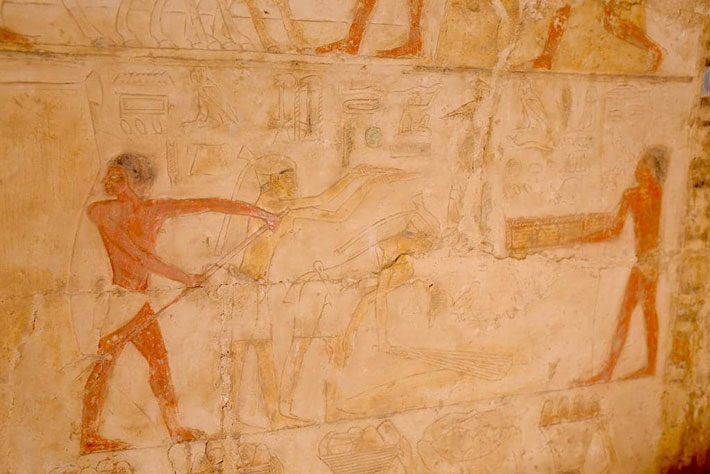 CAIRO, EGYPT—Ahram Online reports that two embalming workshops and two tombs have been unearthed at the Saqqara necropolis. Mostafa Waziri of the Supreme Council of Activities said that the rectangular-shaped workshops have been dated to the 30th Dynasty (380–343 B.C.) and the Ptolemaic period (304–30 B.C.). The first workshop contains the remains of beds thought to have been used to hold the deceased during the mummification process. Made of stone covered with plaster, the beds were equipped with gutters. Pottery, tools, and ritual vessels were also recovered from this workshop. Stone beds, pottery, bronze tools, and animal remains were recovered from the second workshop, which was constructed with mud walls and stone floors. “According to initial studies, it is believed that this particular workshop was used for the mummification of sacred animals,” Waziri said. The first of the two tombs, dated to 2400 B.C., is a flat-roofed structure that belonged to an official named Ne Hesut Ba, who served as head scribe and priest of Horus and Maat during the Old Kingdom’s Fifth Dynasty. The second tomb, dated to about 1400 B.C. and the New Kingdom’s 18th Dynasty, had been cut from the rock and belonged to a priest named Men Kheber. To read about another mummy workshop at Saqqara, go to "Mummification Workshop," one of ARCHAEOLOGY's Top 10 Discoveries of the Decade.
CAIRO, EGYPT—Ahram Online reports that two embalming workshops and two tombs have been unearthed at the Saqqara necropolis. Mostafa Waziri of the Supreme Council of Activities said that the rectangular-shaped workshops have been dated to the 30th Dynasty (380–343 B.C.) and the Ptolemaic period (304–30 B.C.). The first workshop contains the remains of beds thought to have been used to hold the deceased during the mummification process. Made of stone covered with plaster, the beds were equipped with gutters. Pottery, tools, and ritual vessels were also recovered from this workshop. Stone beds, pottery, bronze tools, and animal remains were recovered from the second workshop, which was constructed with mud walls and stone floors. “According to initial studies, it is believed that this particular workshop was used for the mummification of sacred animals,” Waziri said. The first of the two tombs, dated to 2400 B.C., is a flat-roofed structure that belonged to an official named Ne Hesut Ba, who served as head scribe and priest of Horus and Maat during the Old Kingdom’s Fifth Dynasty. The second tomb, dated to about 1400 B.C. and the New Kingdom’s 18th Dynasty, had been cut from the rock and belonged to a priest named Men Kheber. To read about another mummy workshop at Saqqara, go to "Mummification Workshop," one of ARCHAEOLOGY's Top 10 Discoveries of the Decade.
Tombs and Workshops Uncovered at Saqqara Necropolis
